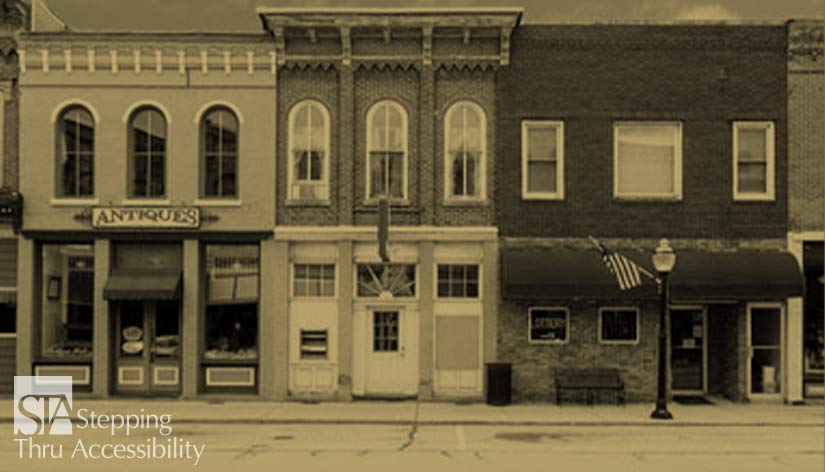Blog
Return to Blog »
Janis Kent, FAIA, Architect, CASp © December, 2014. Updated October 2024 One of the more common questions posed to me, is in regards to existing buildings. Many times it is a very simple question of what do I need to do? But in order to answer this question, other than ‘it depends’, there is a whole list of information that has impact and needs to be known. One question – is the building privately owned, in other words a place of public accommodation, or is it a public facility, such as a city, county, or state building? If it is a privately owned building, then one might need to perform Barrier Removal depending on when the facility was built and/or the economic situation of the ownership. If it is a public building, then one needs to look at the facilities owned by the public entity as a whole and to provide Program Accommodation which may mean tapping into their transition plan. An important question – when was the facility built? If it is a place of Public Accommodation and built pre-ADA, then Barrier Removal is required that is Readily Achievable. If it is a Public Building that was built pre-ADA, then one needs to review the agency’s programs and activities in order to provide Program Accommodation which may necessitate performing construction/alterations or just relocating activities to an accessible location. In the latter case, this is usually determined and shown in the agency’s Transition Plan if it has 50 or more employees. In either case, if the building was built post-ADA, after January 26, 1993, then it should have totally complied. There is no Barrier Removal and no Program Accommodation for those specific buildings since they were required to be accessible. If it is not, then the items should be fixed as non-compliant construction and in California according to the statutes, once a non-complying item is found, it needs to be rectified within 90 days of discovery. Another question that would be asked – has there been any alterations? If an alteration has been performed since January 26, 1992, then the altered area should totally comply. Additionally the Path of Travel (POT) supporting the altered area would have needed to be upgraded. Whether this POT for alterations in Places of Public Accommodation, would be totally compliant depends upon the construction costs at that time and what could be done using the 20% Proportional Spending budget. If over the Valuation Threshold in California, the full POT may have needed to be upgraded. For Public Buildings altered after January 26, 1992, the supporting Path of Travel for Program Accommodation should be fully accessible. If a renovation was done, then the 20% Proportional Spending now applies to the POT, but only if the altered area was not for Program Accommodation. Some Public Buildings were originally constructed and altered under UFAS which does not have a requirement for POT upgrades. But since the 2010 ADAS went into affect, UFAS can not longer be used for altering public facilities. And one of the last questions to ask for a very quick overview of necessary information – are there any elements such as pools, play areas, saunas/steam rooms, exercise equipment, etc? There are over a dozen items that are new to the 2010 ADA Standards which became effective March 15, 2012. If any of these items exist in the facility, then Barrier Removal or Program Accommodation would need to be addressed whether the building is an older pre-ADA building or a building that was recently constructed or altered before the 2012 date. If it is a Public Building, then these items may need to be added to the transition plan in order to be addressed. This is by no means a definitive list to understand what needs to be done for an existing facility. There are also a myriad of other questions. To name a few – Is it an employee only work area or a Place of Commerce where there are only employees? What is the nature of the tenants – public entity in a private facility, or private business leasing and running a space from a public agency? What about other federal agencies, whether they own or lease part or all of a space? Is this a private club or a religious institution? As you can see, before you can even determine what needs to be done to an existing building, there are a myriad of questions that need to be answered in order to determine requirements. So the answer to the original question, we are back to…it depends. And, remember, in California, if performing an alteration, then the altered area and its supporting POT need to comply with the preceding CBC in order to receive Safe Harbor, whereas under ADA, it would be complying with the preceding ADA or UFAS for Safe Harbor. Nothing in this article constitutes legal or design advice for a particular project or circumstance. Be aware that your local City or County may have additional requirements that are different or more restrictive than the State or Federal requirements. Also, this article is an interpretation and opinion of the writer which may vary for a particular project or due to other circumstances. It is meant as a general summary – current original regulations should always be reviewed when making any decisions and specific advice by a qualified professional should be secured for a particular project or circumstance. © Janis Kent, Architect, CASp 2024Existing Buildings – What needs to be done?
